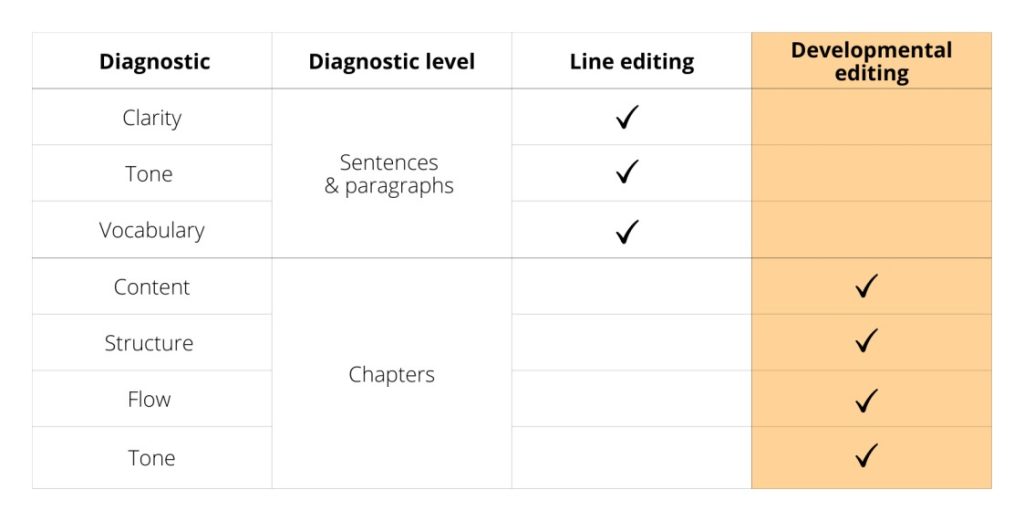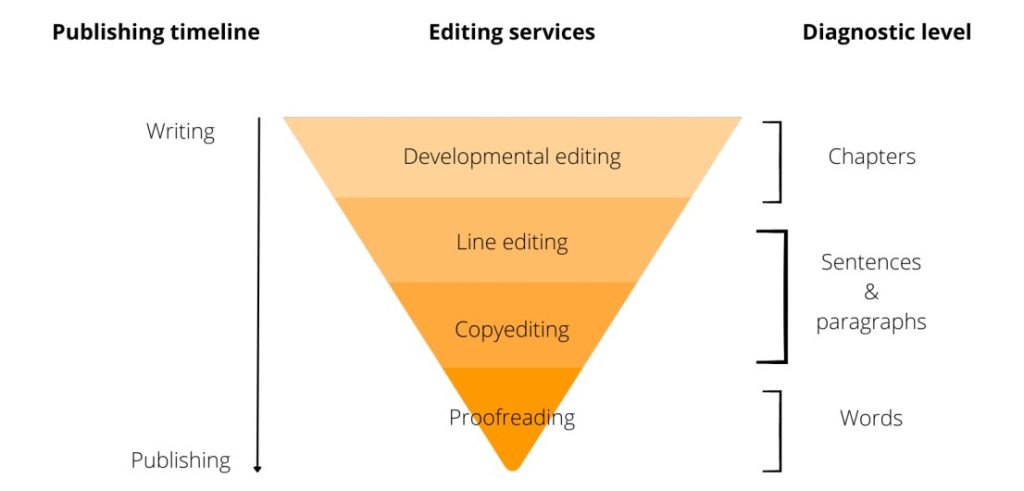Developmental editing looks at the ‘big-picture’ of the manuscript. It checks argumentation, whether the core message is clearly formulated, and if the analysis of the evidence supports every argument. Developmental editing considers the flow and sequence of the sections and whether they support the arguments and conclusions. It also addresses issues with gaps or repetitions.
Developmental editing vs substantive editing | What is it? | What is included? | What is not included? | When to hire an editor? | Pricing | Developmental editing vs line editing | What next? | Other editing
Improve your message
Tidy up the sequences
Diagnose any ‘big-picture’ issues
Polish your argument
What is the difference between developmental editing and substantive editing?
Developmental editing is sometimes referred to as substantive, content, structural or comprehensive editing. This may be confusing since some editors also use the term ‘substantive editing’ to describe what may be often called ‘line editing.’
Why is developmental editing important?
Developmental editing is important because it diagnoses any issues with the structure, clarity, tone and flow of the manuscript that author might not be able to identify. It also considers if any content should be added or removed. Developmental editing may help to sharpen your book’s argument, message, story or plot and ensure it speaks to your target reader.
What does developmental editing include?
Developmental editing diagnoses the ‘big-picture’ issues, such as those with structure, clarity, tone and flow. It also considers if the manuscript meets its objectives, for instance, if:
- it aligns with the genre of choice
- the elements typical for the genre are presented in a way engaging for the reader
- it will meet the expectations of the readers familiar with this topic/genre
- it is structured appropriately to convey the argument or message
- it communicates the argument or message clearly, and the supporting ideas are organised in a logical sequence
- the theme is clearly outlined throughout the book
- the style, voice and point of view are consistent throughout the book and effectively convey your points
- there are any obvious gaps or any sections that repeat each other.
In non-fiction books, especially non-narrative non-fiction such as academic and professional publications, argument is what the storyline is in fiction — the foundation and premise of the book. Thus, developmental editing pays special attention to the argument and its supporting elements. For instance, a part of developmental editing could be considering the following questions relevant to the argument:
- what is the central argument?
- has the author provided enough research-based evidence to support the central argument?
- do all peripheral points and arguments lead to support the central argument or are there elements that contradict it?
- are all parts of the text supporting the argument clearly, without a risk of confusing the reader?
- are there any gaps or repetitions in the argument?
- has the author provided enough context information to support the argument and make it relevant?
- what assumptions has the author made about the reader’s background knowledge?
A final deliverable of the developmental editing is an editorial report containing the editor’s notes, comments and suggestions. The report may include three elements: summary, main advice and detailed feedback:
- a summary of the text will outline the aims of the text, its central argument and its target reader according to the editor,
- main advice may include a summary of what is working well in the text, the essential points that the author needs to address before the manuscript can be considered fit for publishing or go through the following editing stages,
- detailed feedback could be a discussion of each chapter that notes the chapter’s overall flow and organisation and points out any areas for improvement or other areas that the author should be aware of.
What is not included in developmental editing?
Developmental editing looks at the problems holistically and does not address issues in individual sentences such as spelling, punctuation or grammar. In contrast to other editing services, which usually provide a style sheet, no style sheet is produced during developmental editing. Instead, an editorial report is usually written at the end of the developmental editing process.
Likewise, before engaging a copyeditor or proofreader you can expect to receive a sample edit, which most often determines if the editor is a good fit for your text. This is not possible in the case of developmental editing since it pinpoints problems with the text on a ‘big-picture’ level rather than working on clarity, correctness and consistency of the language of the text.
When should you hire a developmental editor?
Developmental editing is usually the first editorial intervention in the manuscript. Developmental editing is conducted early in the process of preparing a manuscript for publication to allow for any necessary changes or additions before the text goes through other editorial processes, such as copyediting or proofreading, where more attention is paid to the correctness and consistency of words and sentences.
What should you consider when hiring a developmental editor?
It is crucial to find a developmental editor who can understand the needs of your text and who has prior experience working with the genre of your text. You can inspect their portfolio to ensure that they are the right fit for your text. Moreover, you should clearly outline your expectations (this is called a ‘brief’) and understand how the editor will communicate their feedback. You should consider if the editor is a member of a professional editorial body, which means they are likely to have received formal training and follow a code of practice.
Ask how the editor provides feedback
Some editors provide an editorial report as a part of the developmental editing service. Find out what they include in their report and how they convey their suggestions. This is important because some people may respond better to encouraging notes, while others may prefer a direct tone.
Check what the editor reads and edits the most
Find out what is the editor’s specialism. Knowing what genre they read and edit most often will tell if editing your text is within the editor’s skillset. Examples of their past work and clients’ testimonials will demonstrate a track record of working with the genre of your choice, and that is a good reassurance that they will be able to deliver a valuable contribution.
Find out about the editor’s qualifications
Language is not a static monolith; it evolves with our culture, society, science and technology, changing and developing over time. For this reason, perhaps, editors, more than other professional groups, must not neglect their professional development to stay up-to-date with the developments in their subject matter. Joining a professional body that offers a peer network and training is one of the ways that developmental editors may refresh their knowledge. There are global organisations for editors, such as the Editorial Freelancers Association, which offers such opportunities. Regionally, in the UK, there is the Chartered Institute of Editing and Proofreading (CIEP), and in North America — ACES: The Society for Editing and the Northwest Editors Guild. So, when hiring a developmental editor, it might be worth checking if they are a member of any accredited organisation.
How much should you pay for developmental editing?
The current hourly rates suggested by the CIEP for developmental editing start from £41.10. Hourly rates in this region will be quoted by professional editors who can justify them with their expertise, training and experience. If you receive a lower estimation for developmental editing, the service might likewise represent a lower quality of editing.
However, what goes into the editor’s pay is more than what meets the eye besides editing and writing editorial reports. For instance, developmental editors first read the entire manuscript more than once, sometimes 3–4 times, to be able to diagnose the high-level issues in the text. Developmental editing does not look at sentences or paragraphs, but rather does the argument, message and voice of the book compose a cohesive whole that meets its objectives.
What is the difference between developmental editing and line editing?
Although there may be some overlap, developmental editing and line editing perform two different functions. Developmental editing focuses on the ‘big-picture’ elements, such as argument, sequencing, gaps, repetitions, structure, genre and reader’s expectations, while line editing tightens up the paragraphs and sentences paying more attention to their flow, clarity and vocabulary.

What should happen after developmental editing?
Developmental editing usually is the first of many processes that prepare the text for publication, and it may not be the only type of editing your text will need. It takes place before line editing, copyediting and proofreading. Line editing ensures that your plot line or argument is conveyed in the clearest and most appealing way possible. Next, a copyedit should occur when you are happy with your argument but want to polish the presentation of the language, including grammar, spelling and inconsistencies. The last step, proofreading, is the final light-touch check ensuring that the text consistently reflects all the language decisions made during previous editing processes. Proofreading also addresses formatting and layout, thus preparing the text for typesetting.

Can a developmental editor do other types of editing?
Yes and no. Yes, because many editors perform different editorial services, and when considering employing a developmental editor to carry out another editorial service, find out what their competencies are. For the same reason, the answer may be ‘no’ because they might not be trained to carry out those more granular processes, like copyediting and proofreading.
Note that developmental editing and proofreading require very different skill sets since they work with different aspects of a text. Developmental editing looks at it as a whole and, from this perspective, diagnoses any issues, while proofreading or copyediting focuses on the language technicalities.
Another reason could be that the more an editor works with a text, the more they become familiar with it, and perhaps it might be challenging for the same editor to offer a fresh eye required for another stage of editing.


